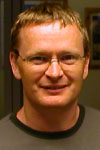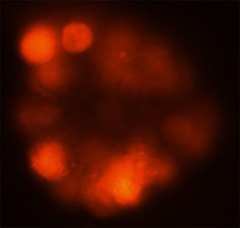
Laboratory for Genome repair and regulation
Repair of DNA damage is essential for protection against cancer and other age related diseases. Such diseases are believed to be initiated by mutations and rearrangements of the DNA sequence.DNA damage generated by ionising radiation, simple alkylating agents or endogenously hydrolytic and oxidative processes is corrected by the base excision repair (BER) pathway.
Challenges
We use standard molecular biology strategies, including the construction of cells and animals lacking specific DNA repair functions, to Identify and characterize gene-functions for repair of DNA damage. Such models aim to elucidate the contribution of single genes for protection against mutations, genomic instability, ageing and ageing related diseases such as cancer. Several collaborations, internationally and within the Centre for Molecular Biology and Neuroscience, have been initiated.
Projects
- DNA repair genes: We use homology based sequence analysis to identify and characterise DNA repair genes from mammalian cells.
- Genomic (in)stability: We have established several cell lines and mice carrying null mutations for specific DNA repair functions. Such models, including those supplied by our collaborators, are used to identify genes involved in maintenance of genomic stability.
- Cell and animal models with altered DNA repair capacity: Several new genes for DNA repair have been identified following the publication of the human DNA sequence. We design constructs for targeted mutations of such genes in cells and mice.
- DNA repair deficiency and brain development: Genetic diseases caused by defective DNA repair are almost always associated with neurological abnormalities. Collaborations have been established within the Centre to identify the neurological defects associated with indivudual DNA repair activities.
- Genomic (in)stability and ageing in DNA repair deficient strains of yeast, S.cerevisiae.
Recent achievements
Characterization of enzymes required for repair of base lesions
in DNA, by the base
excision repair pathway (EMBO J. 1997, 16, 3341-3348; Mol. Cell
1999, 3, 33-42). Transcription coupled repair of oxidative DNA damage
(PNAS 2000, 97, 8397-8402; Mol Cell, 2003, 12, 799-800). Construction
of gene-targeted knockout mice (PNAS 1999, 96, 13300-13305; MCB,
2003, 23, 5346-5353).
Group leader
 Professor
Arne Klungland
Professor
Arne Klungland
Centre for Molecular Biology and Neuroscience
Department of Microbiology
Oslo University Hospital
Rikshospitalet
PO Box 4950 Nydalen
NO-0424 Oslo, Norway
Tel: +47 23074072
Fax: +47 23074061
E-mail: arne.klungland@labmed.uio.no

Induced oxidative stress leads to apoptosis in Fen1 mutant blastocysts (MCB, 2003).
PO Box 1105 Blindern, NO-0317 Oslo, Norway. Tel: +47 22851528. Fax: +47 22851488